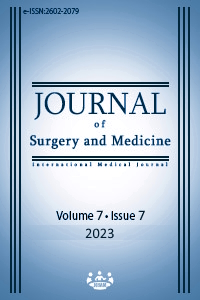Sealing of esophageal perforation with a fully covered biliary stent in a pediatric patient
Esophageal stenting for esophageal perforation
Keywords:
Esophageal perforation, conservative treatment, esophageal stent, fully covered self-expandable metallic stents, biliary stents, pediatricsAbstract
Conservative treatment for esophageal perforations can cause problems related to both nutrition and wound healing in pediatric patients due to its long duration. This case report presents a 14-month-old female patient who underwent endoscopic balloon dilatation for esophageal stricture. The patient had been operated on for esophageal atresia in the neonatal period. Eight hours after discharge, the patient was hospitalized again due to esophageal perforation. Although conservative treatment lasting three weeks was the preferred method, it was unsuccessful. Therefore, a fully covered biliary stent was used instead of an esophageal stent, as the appropriate size stent could not be found. The stent sealed the perforation, and the patient started to be fed orally on the third day. The esophageal stent was removed on the 17th day, and no leakage was observed on the esophagogram. Although conservative methods are the first-line treatment for esophageal perforations in children, their long duration and the inability to feed for a long time are significant disadvantages. Fully covered self-expandable esophageal stents may be a reliable alternative for sealing esophageal perforations in pediatric patients, as they are in adults.
Downloads
References
Gander JW, Berdon WE, Cowles RA. Iatrogenic esophageal perforation in children. Pediatr Surg Int. 2009;25(5):395-401. DOI: https://doi.org/10.1007/s00383-009-2362-6
Martinez L, Rivas S, Hernández F, Avila LF, Lassaletta L, Murcia J, et al. Aggressive conservative treatment of esophageal perforations in children. J Pediatr Surg. 2003 May;38(5):685-9. doi: 10.1016/jpsu.2003.50183. PMID: 12720170. DOI: https://doi.org/10.1016/jpsu.2003.50183
Lange B, Demirakca S, Kähler G, Weiß C, Wessel L, Kubiak R. Experience with Fully Covered Self-Expandable Metal Stents for Esophageal Leakage in Children. Klin Padiatr. 2020 Jan;232(1):13-9. English. doi: 10.1055/a-1014-3179. Epub 2019 Oct 16. PMID: 31618788. DOI: https://doi.org/10.1055/a-1014-3179
Manfredi MA, Clark SJ, Staffa SJ, Ngo PD, Smithers CJ, Hamilton TE, et al. Endoscopic Esophageal Vacuum Therapy: A Novel Therapy for Esophageal Perforations in Pediatric Patients. J Pediatr Gastroenterol Nutr. 2018 Dec;67(6):706-12. doi: 10.1097/MPG.0000000000002073. PMID: 29927863. DOI: https://doi.org/10.1097/MPG.0000000000002073
El-Asmar KM, Elghandour MM, Allam AM. Iatrogenic esophageal perforation caused by endoscopic dilatation of caustic stricture: Current management and possibility of esophageal salvage. J Pediatr Surg. 2021;56(4):692-6. DOI: https://doi.org/10.1016/j.jpedsurg.2020.05.038
Rentea RM, St Peter SD. Neonatal and pediatric esophageal perforation. Semin Pediatr Surg. 2017;26(2):87-94. DOI: https://doi.org/10.1053/j.sempedsurg.2017.02.005
Fernandez FF, Richter A, Freudenberg S, et al.Treatment of endoscopic esophageal perforation. Surg Endosc. 1999;13(10):962-6. DOI: https://doi.org/10.1007/s004649901147
Jones WG 2nd, Ginsberg RJ. Esophageal perforation: a continuing challenge. Ann Thorac Surg. 1992;53(3):534-43. DOI: https://doi.org/10.1016/0003-4975(92)90294-E
Panieri E, Millar AJ, Rode H, Brown RA, Cywes S. Iatrogenic esophageal perforation in children: patterns of injury, presentation, management, and outcome. J Pediatr Surg. 1996 Jul;31(7):890-5. doi: 10.1016/s0022-3468(96)90404-2. PMID: 8811550. DOI: https://doi.org/10.1016/S0022-3468(96)90404-2
Fallon BP, Overman RE, Geiger JD, Jarboe MD, Kunisaki SM. Efficacy and risk profile of self-expandable stents in the management of pediatric esophageal pathology. J Pediatr Surg. 2019 Jun;54(6):1233-8. doi: 10.1016/j.jpedsurg.2019.02.025. Epub 2019 Feb 28. PMID: 30890268. DOI: https://doi.org/10.1016/j.jpedsurg.2019.02.025
Rollins MD, Barnhart DC. Treatment of persistent esophageal leaks in children with removable, covered stents. J Pediatr Surg. 2012;47(10):1843-7. DOI: https://doi.org/10.1016/j.jpedsurg.2012.05.001
Vermeulen BD, Siersema PD. Esophageal Stenting in Clinical Practice: an Overview. Curr Treat Options Gastroenterol. 2018;16(2):260-73. DOI: https://doi.org/10.1007/s11938-018-0181-3
Best C, Sudel B, Foker JE, Krosch TC, Dietz C, Khan KM. Esophageal stenting in children: indications, application, effectiveness, and complications. Gastrointest Endosc. 2009 Dec;70(6):1248-53. doi: 10.1016/j.gie.2009.07.022. PMID: 19836746. DOI: https://doi.org/10.1016/j.gie.2009.07.022
Jung CFM, Müller-Dornieden A, Gaedcke J, Kunsch S, Gromski MA, Biggemann L, et al. Impact of Endoscopic Vacuum Therapy with Low Negative Pressure for Esophageal Perforations and Postoperative Anastomotic Esophageal Leaks. Digestion. 2021;102(3):469-79. doi: 10.1159/000506101. Epub 2020 Feb 11. PMID: 32045916. DOI: https://doi.org/10.1159/000506101
Downloads
- 308 535
Published
Issue
Section
How to Cite
License
Copyright (c) 2023 Mustafa Okumuş
This work is licensed under a Creative Commons Attribution-NonCommercial-NoDerivatives 4.0 International License.
















